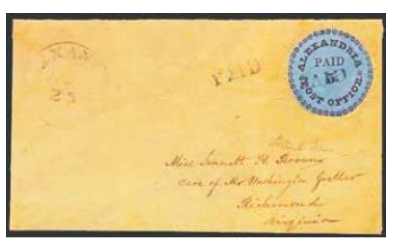
History of the Murray-Dick-Fawcett House
History of the House
Construction on the Murray-Dick-Fawcett house at 517 Prince St. was started in 1772, before the American Revolution. The building was expanded soon after, and by 1816 was much the way it is today – a rambling, sturdy example of vernacular architecture that has been home to generations of Alexandria residents. It is not a grand house, like John Carlyle’s. But it is the least altered house that survives, with roof trusses fastened with hand-wrought nails, the original pine floor and batten doors, privies and a smokehouse, all showing the wear and tear of people living lives mostly out of the limelight of celebrity. A kitchen fireplace used for cooking in the 1790s still burns wood to warm the place.
The 1½-story oldest part of the house was covered in wide white shiplap siding around 1774. The west side facing St. Asaph Street is a stark contrast. When board was removed in 2001, it revealed the red timbers of the shed-like 1784 addition that doubled the house size. The garden area on the .3-acre lot held a 20th-century church community building until 1970, and before that a Chinese laundry, grocery, and plumbing and carpentry shops.
Urban renewal transformed the 500 block of King Street, but the house defied change. The towering 20th-century courthouse complex on King Street overlooks its 19th-century tin roof.
Murray, Dick and Fawcett

The house is named after three early owners: Irish-born Patrick Murray, who opened a livery stable “to take in gentleman’s horses;” Elisha Cullen Dick, a physician who was at George Washington’s deathbed; and the Fawcetts, descendants of merchant John Douglass Brown who bought the house in 1816. The house stayed in Brown’s family for 184 years, often with several generations living together.
Brown's daughter Jannett’s courtship by J. Wallace Hooff was memorialized in a love letter that bore the rare million-dollar Blue Boy stamp. The Hooffs inhabited the house during the Civil War and hid the family silver so Union troops who occupied Alexandria would not confiscate it.
Their daughter Mary married Edward Stabler Fawcett, and Fawcett's son Lewis opened the house to public eyes in 1936 for the Historical American Buildings Survey. Features documented then remain unchanged, including three privies and a smokehouse with blackened walls.
The story of the Brown family has been preserved through merchant shipping papers, Civil War letters, family photographs, and notebooks that detail business and personal expenses. Family clothing dating to the 18th century was donated to the Lyceum—a woman’s petticoat, a skirt and bodice, a hunting jacket, baby clothes, and more. From the 20th century are maid uniforms worn by Martha Blue, a Black woman who worked for the Fawcett family for nearly 30 years.
Timeline
1749 Alexandria established in grid plan, sold in quarter-block lots
1762 Town expands, includes this lot. Town line had ended in what is today the middle of the block between South Pitt and Saint Asaph streets.
1772 Patrick Murray begins building 32-foot-wide timber-frame structure on stone foundation
1774 Murray leases half-acre lot from John Alexander, a descendant of the town founder
1784 Murray enlarges house with two-room shed-roofed addition
1785 Murray opens livery stable
1786 Murray defaults on mortgage
1792 Murray runs newspaper ad to sell house; house sold at sheriff’s sale [lot subdivide]
1794 Dr. Elisha Cullen Dick purchases property
1794 Merchants John Thomas Ricketts and William Newton buy, subdivide property
1795-1797 Rooms above kitchen, smokehouse, laundry added; perhaps privies, too
1806 William Smith buys house
1816 Merchant John Douglass Brown buys house
1830 Starting with daughter Mary Goulding Gretter Brown, family descendants inherit
1936 “Fawcett House” is part of American Historical Buildings Survey (HABS)
1976 John Douglass Brown House plaque placed by Daughters of the American Revolution
2000 Brown descendant Richard L. Cheeseman sells property to Charles Joseph Reeder
2002 New kitchen and bath addition constructed with repurposed materials
2017 City of Alexandria acquires Murray-Dick-Fawcett House
Learn More
- The Murray-Dick-Fawcett House; A Future Alexandria Museum, by Sue Kovach Shuman, The Alexandria Chronicle, Spring 2019. This is the story of the house and of those who lived there.
- A gem of a house on Prince Street, originally printed in Out of the Attic, Alexandria Times, July 20, 2017.
- The Murray-Dick-Fawcett House at 250, originally printed in Out of the Attic, Alexandria Times, May 20, 2020.